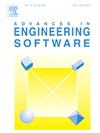Hybrid material topology optimization of solid-lattice structures for natural frequency maximization
IF 5.7
2区 工程技术
Q2 COMPUTER SCIENCE, INTERDISCIPLINARY APPLICATIONS
引用次数: 0
Abstract
This paper presents a topology optimization design approach for hybrid materials used to generate solid-lattice structures. Specifically, the approach aims to maximize the natural frequencies of hybrid structures by optimizing the topological distribution of solid and lattice materials, as well as the lattice relative density. For this purpose, a hybrid material interpolation model is developed. In this approach, the modal assurance criterion (MAC) is applied to optimize the target-order natural frequency accurately. Additionally, a hybrid structure post-processing framework based on the signed distance field (SDF) is proposed. This framework adaptively refines the lattice resolution at model boundaries, ensuring geometric integrity. Moreover, a circular geometry transition strategy is employed to improve structural connectivity, which significantly reduces model errors in non-transition regions. 2D and 3D numerical examples demonstrate the proposed method’s effectiveness in maximizing the natural frequency of hybrid structures. In particular, the dynamic performance of hybrid structures surpasses that of pure solid structures under multiple mass loading cases.
基于固有频率最大化的混合材料固体晶格结构拓扑优化
本文提出了一种用于生成固体晶格结构的杂化材料的拓扑优化设计方法。具体来说,该方法旨在通过优化固体和晶格材料的拓扑分布以及晶格相对密度来最大化混合结构的固有频率。为此,建立了一种混合材料插值模型。该方法采用模态保证准则(MAC)对目标阶固有频率进行精确优化。此外,提出了一种基于符号距离域(SDF)的混合结构后处理框架。该框架自适应细化模型边界的格分辨率,保证几何完整性。此外,采用圆形几何过渡策略提高了结构连通性,显著降低了非过渡区域的模型误差。二维和三维数值算例验证了该方法在最大化混合结构固有频率方面的有效性。特别是混合动力结构在多重质量荷载作用下的动力性能优于纯实体结构。
本文章由计算机程序翻译,如有差异,请以英文原文为准。
求助全文
约1分钟内获得全文
求助全文
来源期刊

Advances in Engineering Software
工程技术-计算机:跨学科应用
CiteScore
7.70
自引率
4.20%
发文量
169
审稿时长
37 days
期刊介绍:
The objective of this journal is to communicate recent and projected advances in computer-based engineering techniques. The fields covered include mechanical, aerospace, civil and environmental engineering, with an emphasis on research and development leading to practical problem-solving.
The scope of the journal includes:
• Innovative computational strategies and numerical algorithms for large-scale engineering problems
• Analysis and simulation techniques and systems
• Model and mesh generation
• Control of the accuracy, stability and efficiency of computational process
• Exploitation of new computing environments (eg distributed hetergeneous and collaborative computing)
• Advanced visualization techniques, virtual environments and prototyping
• Applications of AI, knowledge-based systems, computational intelligence, including fuzzy logic, neural networks and evolutionary computations
• Application of object-oriented technology to engineering problems
• Intelligent human computer interfaces
• Design automation, multidisciplinary design and optimization
• CAD, CAE and integrated process and product development systems
• Quality and reliability.
 求助内容:
求助内容: 应助结果提醒方式:
应助结果提醒方式:


